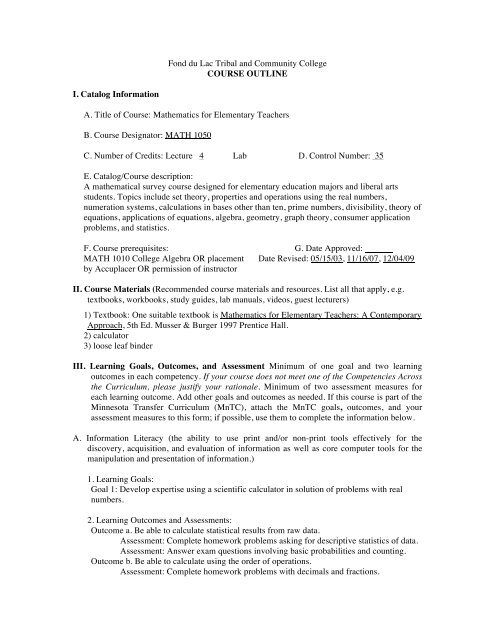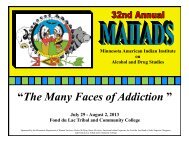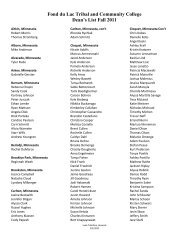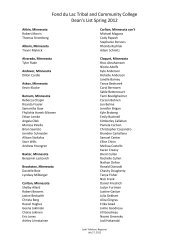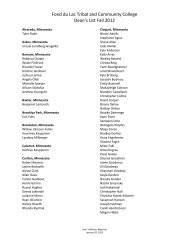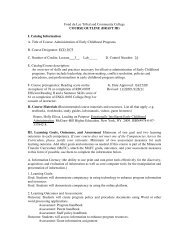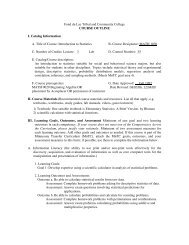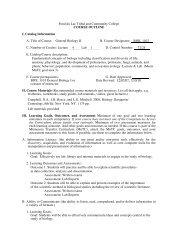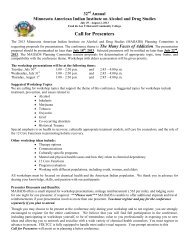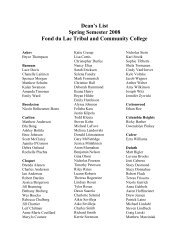MATH 1050 Mathematics for Elementary Teachers - Fond Du Lac ...
MATH 1050 Mathematics for Elementary Teachers - Fond Du Lac ...
MATH 1050 Mathematics for Elementary Teachers - Fond Du Lac ...
Create successful ePaper yourself
Turn your PDF publications into a flip-book with our unique Google optimized e-Paper software.
<strong>Fond</strong> du <strong>Lac</strong> Tribal and Community College<br />
COURSE OUTLINE<br />
I. Catalog In<strong>for</strong>mation<br />
A. Title of Course: <strong>Mathematics</strong> <strong>for</strong> <strong>Elementary</strong> <strong>Teachers</strong><br />
B. Course Designator: <strong>MATH</strong> <strong>1050</strong><br />
C. Number of Credits: Lecture 4 Lab D. Control Number: 35<br />
E. Catalog/Course description:<br />
A mathematical survey course designed <strong>for</strong> elementary education majors and liberal arts<br />
students. Topics include set theory, properties and operations using the real numbers,<br />
numeration systems, calculations in bases other than ten, prime numbers, divisibility, theory of<br />
equations, applications of equations, algebra, geometry, graph theory, consumer application<br />
problems, and statistics.<br />
F. Course prerequisites: G. Date Approved:<br />
<strong>MATH</strong> 1010 College Algebra OR placement Date Revised: 05/15/03, 11/16/07, 12/04/09<br />
by Accuplacer OR permission of instructor<br />
II. Course Materials (Recommended course materials and resources. List all that apply, e.g.<br />
textbooks, workbooks, study guides, lab manuals, videos, guest lecturers)<br />
1) Textbook: One suitable textbook is <strong>Mathematics</strong> <strong>for</strong> <strong>Elementary</strong> <strong>Teachers</strong>: A Contemporary<br />
Approach, 5th Ed. Musser & Burger 1997 Prentice Hall.<br />
2) calculator<br />
3) loose leaf binder<br />
III. Learning Goals, Outcomes, and Assessment Minimum of one goal and two learning<br />
outcomes in each competency. If your course does not meet one of the Competencies Across<br />
the Curriculum, please justify your rationale. Minimum of two assessment measures <strong>for</strong><br />
each learning outcome. Add other goals and outcomes as needed. If this course is part of the<br />
Minnesota Transfer Curriculum (MnTC), attach the MnTC goals, outcomes, and your<br />
assessment measures to this <strong>for</strong>m; if possible, use them to complete the in<strong>for</strong>mation below.<br />
A. In<strong>for</strong>mation Literacy (the ability to use print and/or non-print tools effectively <strong>for</strong> the<br />
discovery, acquisition, and evaluation of in<strong>for</strong>mation as well as core computer tools <strong>for</strong> the<br />
manipulation and presentation of in<strong>for</strong>mation.)<br />
1. Learning Goals:<br />
Goal 1: Develop expertise using a scientific calculator in solution of problems with real<br />
numbers.<br />
2. Learning Outcomes and Assessments:<br />
Outcome a. Be able to calculate statistical results from raw data.<br />
Assessment: Complete homework problems asking <strong>for</strong> descriptive statistics of data.<br />
Assessment: Answer exam questions involving basic probabilities and counting.<br />
Outcome b. Be able to calculate using the order of operations.<br />
Assessment: Complete homework problems with decimals and fractions.
Assessment: Answer exam problems calculating with explicit and implied<br />
parenthesis.<br />
B. Ability to Communicate (the ability to listen, read, comprehend, and/or deliver in<strong>for</strong>mation in<br />
a variety of <strong>for</strong>mats.)<br />
Communication as a general goal is not addressed directly in mathematics courses.<br />
C. Problem Solving (the ability to conceptualize, apply, analyze, synthesize, and/or evaluate<br />
in<strong>for</strong>mation to <strong>for</strong>mulate and solve problems.)<br />
1. Learning Goals:<br />
Goal 1: Solve applied problems by analytic and geometric methods.<br />
2. Learning Outcomes and Assessments:<br />
Outcome a. Be able to solve applied problems with graphical analysis.<br />
Assessment: Solve homework exercises involving drawing of geometric figures<br />
Assessment: Answer exam problems with descriptive graphs.<br />
Outcome b. Be able to translate word problems into equations <strong>for</strong> technical solution.<br />
Assessment: Complete homework problems using algebraic equations.<br />
Assessment: Answer exam problems requiring simple inequalities in applications.<br />
D. Culture (knowledge of Anishinaabe traditions and culture, knowledge of one’s own traditions<br />
and culture, knowledge of others’ traditions and cultures, and/or respect <strong>for</strong> global diversity.)<br />
Culture is not directly addressed in mathematics courses.<br />
Documentation <strong>for</strong> MnTC - None<br />
IV. Course Content (Outline the major topics covered in this course.)<br />
1. Problem solving<br />
2. Set Theory<br />
3. Whole numbers: Operations & Properties<br />
4. Number Theory<br />
5. Computation: Mind, Paper, Calculator<br />
6. Fractions: Operations & Properties<br />
7. Decimals: Operations & Properties<br />
8. Percents: Applications<br />
9. Integers: Operations & Properties<br />
10. Probability<br />
11. Statistics<br />
12. Measurement<br />
13. Geometric Shapes & Properties<br />
(revised October 2009)


